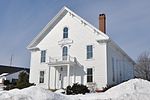Seabrook Station Nuclear Power Plant

The Seabrook Nuclear Power Plant, more commonly known as Seabrook Station, is a nuclear power plant located in Seabrook, New Hampshire, United States, approximately 40 miles (64 km) north of Boston and 10 miles (16 km) south of Portsmouth. It has operated since 1990. With its 1,244-megawatt electrical output, Seabrook Unit 1 is the largest individual electrical generating unit on the New England power grid. It is the second largest nuclear plant in New England after the two-unit Millstone Nuclear Power Plant in Connecticut. Two reactors were planned at Seabrook but the first unit did not begin full operation until 1990, a full 14 years after the construction permit was granted, and the second unit was never built due to construction delays caused by protests, cost overruns, and troubles obtaining financing. The difficulties led to the bankruptcy of Seabrook's utility owner, PSNH. Since 2002, Seabrook Station has been owned and operated by NextEra Energy Resources.
Excerpt from the Wikipedia article Seabrook Station Nuclear Power Plant (License: CC BY-SA 3.0, Authors, Images).Seabrook Station Nuclear Power Plant
South Access Road,
Geographical coordinates (GPS) Address Nearby Places Show on map
Geographical coordinates (GPS)
| Latitude | Longitude |
|---|---|
| N 42.898888888889 ° | E -70.850833333333 ° |
Address
South Access Road
03874
New Hampshire, United States
Open on Google Maps





